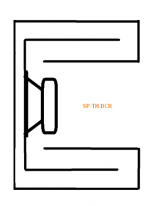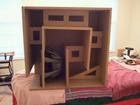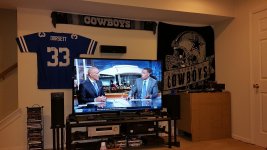Anyway, continued success with your designs, & to the people who build & test & post, All the best with them
Much appreciated Zero D! Maybe someday i will be able to talk you into building one of these wacky acoustic contraptions!!! Hehehe
A theoretical simulation of a port trying to output enough energy to create 144 dBs some distance away does not account for the enormous losses due to turbulence both in the port itself and even more so when the very high air particle velocity and very high pressure leaving the port will mix very turbulently with the still air inside the car cabin.
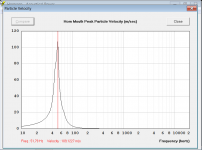
Here is an example of the air particle velocity inside a typical port. 120 cm2 port area, 19 cm port length. 50 liters box size and a Cerwin Vega Stroker 10. 1000 watts and 16 mm xmax.
This is an air raid siren, not a loudspeaker.

Here is an example of the air particle velocity inside a typical port. 120 cm2 port area, 19 cm port length. 50 liters box size and a Cerwin Vega Stroker 10. 1000 watts and 16 mm xmax.
This is an air raid siren, not a loudspeaker.
Tops .... and also some new subwoofer cab information and images
Samuel,
If your JBL Line Array tops have sufficient midbass punch & authority down into the 80hz-100hz range then they should suffice .... If you still wanted to build some tops then we can do that too ...... The Super Planar Tops featured in post #1 did work out rather well
...... The Super Planar Tops featured in post #1 did work out rather well  ..
..
Excellent! We have an updated solid 600 liter plan now .... Dustin should be finished with the 3d sketch soon ... It is based on these details , layout and dimensions (below)
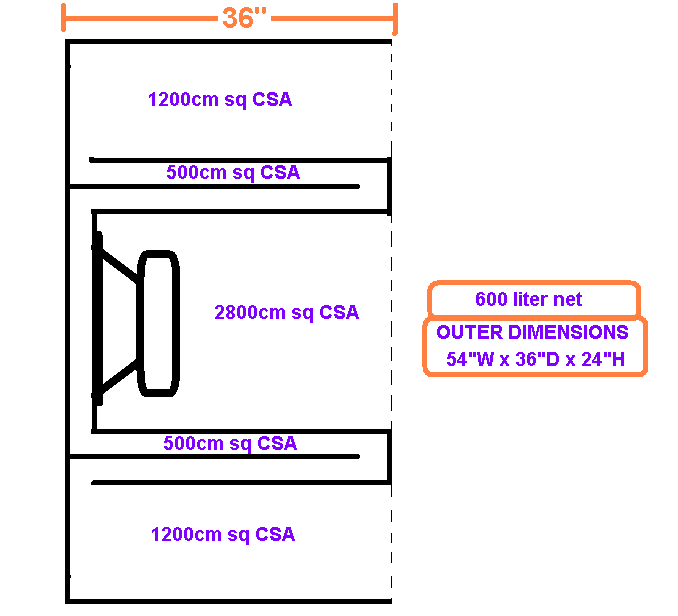
I had to adjust the model by a small amount to make everything fit properly .. Output is still just as extraordinary ... I suppose we could call this revision 2 .. Here is the current sim ..
... I suppose we could call this revision 2 .. Here is the current sim ..
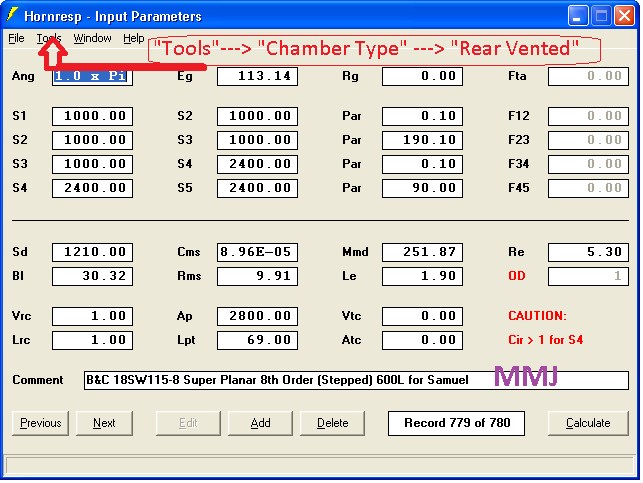
Thank you Mathew Morgan. I do have the smaller line array tops from JBL. But I would be interested in your Compound loaded mid bass/high cabinets.
Samuel,
If your JBL Line Array tops have sufficient midbass punch & authority down into the 80hz-100hz range then they should suffice .... If you still wanted to build some tops then we can do that too
 ..
.. The dimensions of the sub cab is not written in stone. You can come up with an optimized design.
Regards,
Excellent! We have an updated solid 600 liter plan now .... Dustin should be finished with the 3d sketch soon ... It is based on these details , layout and dimensions (below)

I had to adjust the model by a small amount to make everything fit properly .. Output is still just as extraordinary

You are very kind
Johannes ,
I appreciate this tremendously! Thank you so very much! I really admire your innovative spirit as well!
I really admire your innovative spirit as well!  We will just keep hammering away at it!
We will just keep hammering away at it!
Johannes ,
Yes , that sounds about right to me, there is going to be major air particle velocity problems in a Bass Reflex (vented) cabinet trying to produce such an extreme resonant peak, unless the port is made very large ....
Nevertheless speaking of the reflex example given in post #260 the box and port losses will negate (and then some) any decibel advantage that we see there with that ludicrous narrow peak at 50hz ...... As people have pointed out in the past Hornresp simulates cabinets as if they are made with thick concrete panels and lossless ducts, which we know isn't fully realistic.......ANYWAY, the real-world losses will likely knock that reflex box's peak down considerably......... This leaves the Super Planar 8th order example far superior in every way besides build complexity and weight of course ..
...... As people have pointed out in the past Hornresp simulates cabinets as if they are made with thick concrete panels and lossless ducts, which we know isn't fully realistic.......ANYWAY, the real-world losses will likely knock that reflex box's peak down considerably......... This leaves the Super Planar 8th order example far superior in every way besides build complexity and weight of course .. 
Thanks for your continuing effort to explore and develop this idea and share your results with very contagious enthusiasm.
It is people like you Matthew Morgan J that makes this forum a fun place to visit.
Johannes ,
I appreciate this tremendously! Thank you so very much!
 I really admire your innovative spirit as well!
I really admire your innovative spirit as well!  We will just keep hammering away at it!
We will just keep hammering away at it!
A theoretical simulation of a port trying to output enough energy to create 144 dBs some distance away does not account for the enormous losses due to turbulence both in the port itself and even more so when the very high air particle velocity and very high pressure leaving the port will mix very turbulently with the still air inside the car cabin.
Johannes ,
Yes , that sounds about right to me, there is going to be major air particle velocity problems in a Bass Reflex (vented) cabinet trying to produce such an extreme resonant peak, unless the port is made very large ....
Nevertheless speaking of the reflex example given in post #260 the box and port losses will negate (and then some) any decibel advantage that we see there with that ludicrous narrow peak at 50hz

Last edited:
Mr GKH and tops , another note
Samuel , do you know Mr GKH in Austria?
He was working on some plans for a set of dual Eminence Delta 10" loaded Symmetrical path Super Planar tops with a toed-in crossfiring baffle .... He had made good progress on them, great sketches and all ... Could be scaled up for Eminence Kappalite 3012HO drivers ..
Samuel , do you know Mr GKH in Austria?
He was working on some plans for a set of dual Eminence Delta 10" loaded Symmetrical path Super Planar tops with a toed-in crossfiring baffle .... He had made good progress on them, great sketches and all ... Could be scaled up for Eminence Kappalite 3012HO drivers ..
USRFobiwan,
Simulate that model as multiple cabinets (without any added filter) and watch what happens .... It flattens out pretty quick, even in halfspace ... This model behaves sort of like a FLH with undersized mouth in that regard (though not as extreme as the rising response in some FLH models when used as a single)....
Simulate that model as multiple cabinets (without any added filter) and watch what happens .... It flattens out pretty quick, even in halfspace ... This model behaves sort of like a FLH with undersized mouth in that regard (though not as extreme as the rising response in some FLH models when used as a single)....
(not sure if I copied the input right - sure can't spell "planar" on 3hr sleep)
https://i.imgur.com/qLldQj4.jpg
https://i.imgur.com/qLldQj4.jpg
A few different people (here and in other forums) had asked about how the Super Planar 8th order cabinet would look compared to a simple Bass Reflex (vented , Helmholtz) tuned with an intentional peak for usage in SPL competitions ....
This is a valid question and I was curious about it myself so i put together this comparison ..... It is fair , as the tuning, driver, and cabinet volume are all the same .... Same 1/8th space environment .... The same RS 8 subwoofer was driven to it's Xmax rating in both cases ....
An externally hosted image should be here but it was not working when we last tested it.
Mr Vansickle says that his Super Planar 8th order cabinet is "musical" and it is easy to see why he might say that (based on the grey curve) .......
Ok, a couple of notes.
Yes, your box would be more "musical" than the ported burp box example. Not that it matters, the point of a burp box is to burp, not to listen to music. Even your box has no real bass though so it could be argued that neither are "muscial".
Second, your ported example is a really terrible, awful example of a burp box. I can't imagine anyone would build a burp box even remotely similar to that. I get it - you made them both the same size to make it a "fair" comparison but that's not how you make a ported burp box.
If you want to see how it's really done you need only to look to old school Kicker designs. I'll show an example of the design that Kicker recommended for my 12 inch L7 (which I no longer have).
You might notice that the box size is almost 2.5x smaller than your ported example - and this uses a 12 inch driver with 645 sq cm Sd, which is halfway between a normal 12 inch and a 15 inch driver. The box is TINY - it doesn't need to be large for burps.
The driver is also very high qts, which actually helps to get the big spl bump.
And the port is sized for low port velocity. It could be further reduced by half if using big flares. And for that matter, if designed as a flared port in the first place it could be made smaller AND with the velocity reduced by half.
I'm not endorsing this design for anything other than burps, obviously, but it shows that ported burp boxes don't look anything at all like the design you came up with to compare with your high order complex box.
Kicker is not a great brand and they are seriously overpriced but they do know how to design for winning spl comps, and it definitely doesn't require large boxes.


A theoretical simulation of a port trying to output enough energy to create 144 dBs some distance away does not account for the enormous losses due to turbulence both in the port itself and even more so when the very high air particle velocity and very high pressure leaving the port will mix very turbulently with the still air inside the car cabin.
View attachment 637581
Here is an example of the air particle velocity inside a typical port. 120 cm2 port area, 19 cm port length. 50 liters box size and a Cerwin Vega Stroker 10. 1000 watts and 16 mm xmax.
This is an air raid siren, not a loudspeaker.
The only thing this shows is that you don't know how to properly design a ported box.
The HR design in #263 is awful. First you have to EQ out the enormous peak 70-105db with EQ
Yes, that is one way to look at the spl response graph. Another way to look at it is that you have an enormous efficiency in the mid bass. DSP is dirt cheap and that mid bass peak is very easy to EQ flat or to your liking (seldom flat in real life use). In the old pre "dirt cheap DSP" age you always tried to tune your loudspeaker to a flat spl response. Today it is usually better to build a box that maximizes efficiency and takes great care of the driver. Room acoustics will wreak havoc with the spl response anyway.
10 times the sensitivity in the midbass just gives 10 time the headroom in the midbass and one tenth the demand on the amplifiers in that same frequency spectrum.
Regards,
Johannes
Completely
Well said Johannes!
Posting the 1w @1m chart will help put things into perspective .... We are just looking at a high level of efficiency here with these designs ..
Today it is usually better to build a box that maximizes efficiency and takes great care of the driver. Room acoustics will wreak havoc with the spl response anyway.
10 times the sensitivity in the midbass just gives 10 time the headroom in the midbass and one tenth the demand on the amplifiers in that same frequency spectrum.
Regards,
Johannes
Well said Johannes!

Posting the 1w @1m chart will help put things into perspective .... We are just looking at a high level of efficiency here with these designs ..
Well done!
Freddi,
Looks like you got everything exactly right except for the spelling! Hehehe
(not sure if I copied the input right - sure can't spell "planar" on 3hr sleep)
https://i.imgur.com/qLldQj4.jpg
Freddi,
Looks like you got everything exactly right except for the spelling! Hehehe
SP-TH-DCR
@ Matthew Morgan J et al
What do you think of this ?
Super Planer-Tapped Horn-Dual Chamber Reflex
Well, something like that anyway There could be more, or less sections depending on the target goals.
There could be more, or less sections depending on the target goals.
Edit
Regarding the BIG peak, which would sound nasty As mentioned already though, EQing it out = better efficiancy =
As mentioned already though, EQing it out = better efficiancy = 
@ Matthew Morgan J et al
What do you think of this ?
Super Planer-Tapped Horn-Dual Chamber Reflex
Well, something like that anyway
Edit
Regarding the BIG peak, which would sound nasty
Attachments
Last edited:
There's nothing at all special about the Kicker, in fact it's quite unimpressive in all respects. This was the silver cone era for the L7s and qts was 0.666. Not at all special in any way, actually quite unremarkable. Definitely not worth the price Kicker charged.
Kicker won the game and was able to command high prices for one reason only, the box design. When you stick a high q driver in a very undersized ported box you get a massive peak. It sounds terrible (not musical) but it wins comps and sells drivers. The designs are super simple and anyone can make them so you had a generation of dummies driving around in Kicker burpmobiles that sounded terrible when playing actual music.
Kicker won the game and was able to command high prices for one reason only, the box design. When you stick a high q driver in a very undersized ported box you get a massive peak. It sounds terrible (not musical) but it wins comps and sells drivers. The designs are super simple and anyone can make them so you had a generation of dummies driving around in Kicker burpmobiles that sounded terrible when playing actual music.
- Home
- Loudspeakers
- Subwoofers
- Compound loading 6th order quarterwave "Super Planar" horns and pipes concepts/builds
